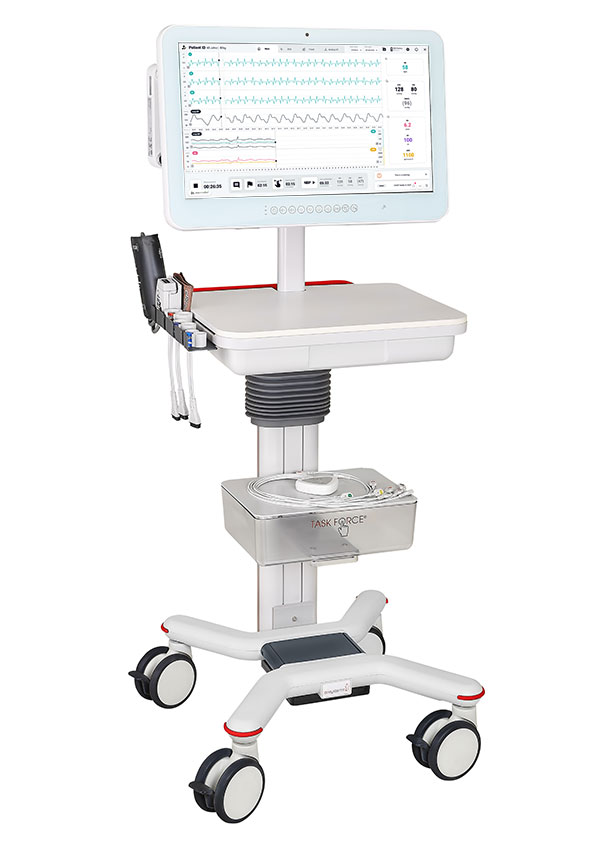Postural Tachycardia Syndrome (POTS) in Long COVID patients
Facts and easy-to-use diagnosis supporting tools
> The number of long COVID patients with symptoms of POTS is reported to be growing (1)
Coronavirus disease 2019 (COVID-19) is a pandemic viral disease that has currently caused more than 6.5 million deaths worldwide, according to John Hopkins University (2). One of the longer term consequences of a COVID infection might be the Postural Tachycardia Syndrome, since numerous studies have been published describing patients who developed POTS after a COVID-19 infection (3–6). POTS commonly occurs after viral or bacterial infections (3,7), which matches with the outcomes of recently published case reports describing patients who suffer from POTS following a COVID-19 infection (8–10). POTS is a form of dysautonomia and manifests itself primarily in an abnormal increase in heart rate upon sitting or standing up, accompanied by symptoms such as dizziness, fatigue and fainting (syncope) (11–13). The number of affected patients is estimated from one to three million people in the US alone (13).

> Additional side effects
POTS as well as other long COVID symptoms cause economic deteriorations to patients and healthcare services and impair quality of life of patients (14). A cross-sectional survey of 5556 adults with POTS reported that 70% have experienced a loss of income and 21% lost their job due to POTS (14). The American Autonomic Society reports increasing waiting lists in tertiary care clinics as the number of specialists familiar with the diagnosis and care of POTS patients is insufficient to manage the large number of patients. The lack of infrastructure and clinical resources is the main problem (8).
> What can be done?
The usual procedure to diagnose POTS providing valuable evidence of autonomic dysfunction is the head-up tilt test with a non-invasive continuous beat-to-beat hemodynamic monitoring (8,10,12,15–18). Since POTS can lead to serious and persistent impairment of quality of life, if it is not adequately treated (11), a profound and reliable diagnosis is essential for further therapeutic steps. Non-invasive and easy-to-use medical devices recording cardiovascular and hemodynamic parameters continuously can support healthcare professionals in diagnosing POTS, reduce economic loss, and assist in the treatment of autonomic dysfunction (14,17).
> Reliable solution for supporting the diagnosis of POTS
CNSystems has specialized on easy-to-use devices for non-invasive, continuous hemodynamic assessment during cardiovascular autonomic function tests. With its new generation, the Task Force® Touch CARDIO workstation, the assessment of autonomic dysfunction such as POTS manifesting in postural tachycardia, orthostatic intolerance, presyncope or syncope has become even easier through
- Quick and easy setup due to dual finger sensor design
- Synchronized patient signals within few minutes: contBP, 12 channel ECG, SV, SVR
- continuous measurement throughout cardiovascular and autonomic assessment
- Configurable application protocols (workflow support) and markers
- Easy post processing & reporting
Let us fight the disease together, starting with a profound and reliable diagnosis.
References:
- Spahic JM, Hamrefors V, Johansson M, Ricci F, Melander O, Sutton R, et al. Malmö POTS symptom score: Assessing symptom burden in postural orthostatic tachycardia syndrome. J Intern Med. 2022;1–9. DOI: 10.1111/joim.13566
- www.coronavirus.jhu.edu/map.html. 2022.
- Blitshteyn S, Whitelaw S. Postural orthostatic tachycardia syndrome (POTS) and other autonomic disorders after COVID-19 infection: a case series of 20 patients. Immunol Res [Internet]. 2021; Available from: doi.org/10.1007/s12026-021-09185-5
- Kanjwal K, Jamal S, Kichloo A, Grubb B. New-onset Postural Orthostatic Tachycardia Syndrome Following Coronavirus Disease 2019 Infection. Journal of Innovations in Cardiac Rhythm Management. 2020 Nov 1;11(11):4302–4. doi: 10.19102/icrm.2020.111102
- Miglis MG, Prieto T, Shaik R, Muppidi S, Sinn DI, Jaradeh S. A case report of postural tachycardia syndrome after COVID-19. Clinical Autonomic Research. 2020 Oct 3;30(5):449–51. doi: 10.1007/s10286-020-00727-9
- Umapathi T, Poh MQW, Fan BE, Li KFC, George J, Tan JYL. Acute hyperhidrosis and postural tachycardia in a COVID-19 patient. Clinical Autonomic Research. 2020 Dec 24;30(6):571–3. doi: 10.1007/s10286-020-00733-x
- www.hopkinsmedicine.org/health/conditions-and-diseases/coronavirus/covid19-and-pots-is-there-a-link. 2020.
- Raj SR, Arnold AC, Barboi A, Claydon VE, Limberg JK, Lucci VEM, et al. Long-COVID postural tachycardia syndrome: an American Autonomic Society statement. Clinical Autonomic Research [Internet]. 2021;1–4. Available from: doi: 10.1007/s10286-021-00798-2
- Varanasi S, Sathyamoorthy M, Chamakura S, Shah SA. Management of Long-COVID Postural Orthostatic Tachycardia Syndrome With Enhanced External Counterpulsation. Cureus. 2021 Sep 30; doi: 10.7759/cureus.18398
- Dani M, Dirksen A, Taraborrelli P, Torocastro M, Panagopoulos D, Sutton R, et al. Autonomic dysfunction in ‘long COVID’: rationale, physiology and management strategies. Clinical Medicine, Journal of the Royal College of Physicians of London. 2021;21(1):E63–7. doi: 10.7861/clinmed.2020-0896
- www.nhs.uk/conditions/postural-tachycardia-syndrome/. 2019.
- www.my.clevelandclinic.org/health/diseases/16560-postural-orthostatic-tachycardia-syndrome-pots. 2022.
- www.hopkinsmedicine.org/health/conditions-and-diseases/postural-orthostatic-tachycardia-syndrome-pots. 2022.
- Bourne KM, Chew DS, Stiles LE, Shaw BH, Shibao CA, Okamoto LE, et al. Postural orthostatic tachycardia syndrome is associated with significant employment and economic loss. J Intern Med. 2021 Jul 15;290(1):203–12. doi: 10.1111/joim.13245
- www.mayoclinic.org/diseases-conditions/coronavirus/in-depth/coronavirus-long-term-effects/art-20490351. 2022.
- Larsen NW, Stiles LE, Miglis MG. Preparing for the long-haul: Autonomic complications of COVID-19. Autonomic Neuroscience. 2021 Nov;235:102841. doi: 10.1016/j.autneu.2021.102841
- Kavi L. Postural tachycardia syndrome and long COVID: an update. British Journal of General Practice. 2022 Jan 31;72(714):8–9. DOI: 10.3399/bjgp22X718037
- Johansson M, Ståhlberg M, Runold M, Nygren-Bonnier M, Nilsson J, Olshansky B, et al. Long-Haul Post–COVID-19 Symptoms Presenting as a Variant of Postural Orthostatic Tachycardia Syndrome. JACC Case Rep. 2021 Apr;3(4):573–80. doi: 10.1016/j.jaccas.2021.01.009



